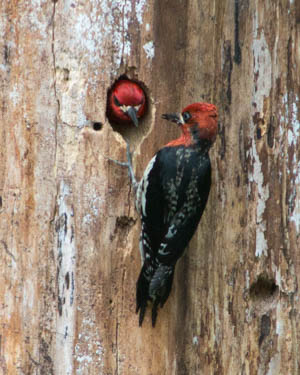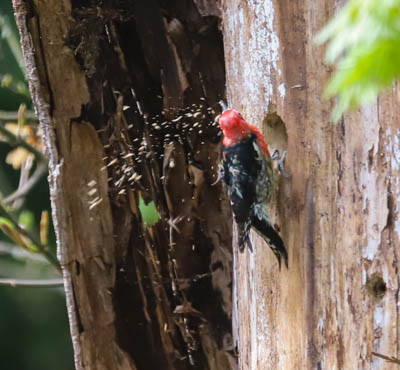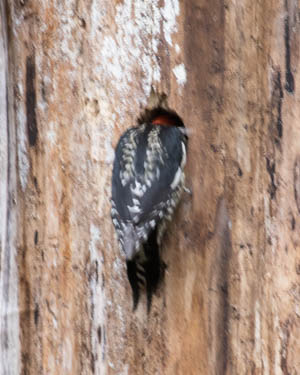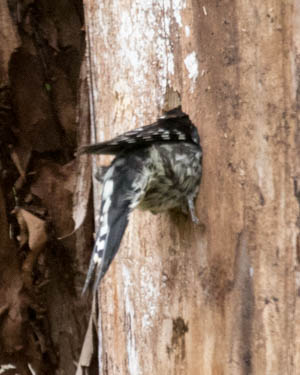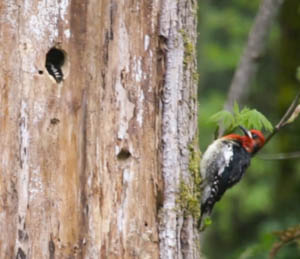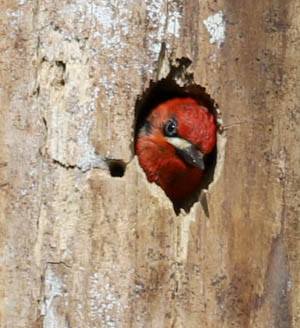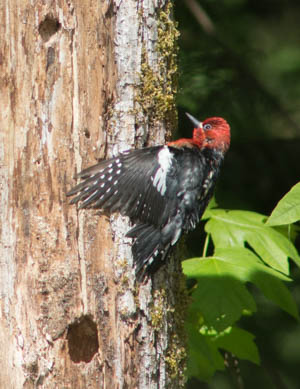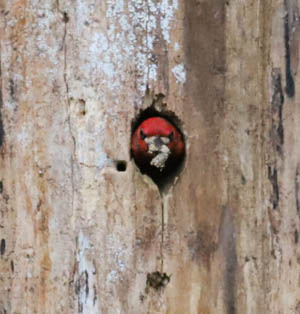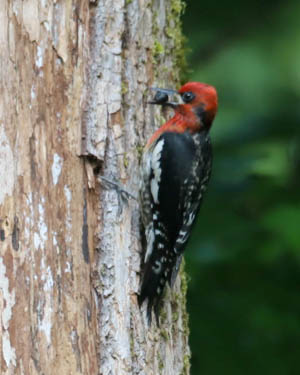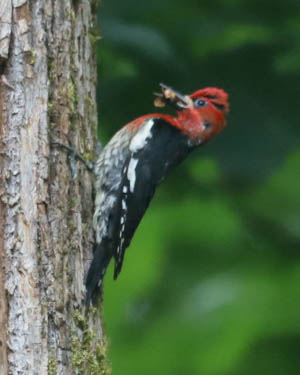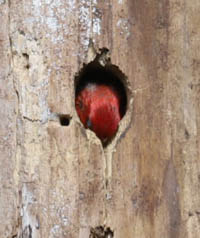|
Red-breasted Sapsuckers
Spring, 2020
Last Updated June 9, 2020
(2 new videos, from 6/8 and 6/9)
This spring, a pair of red-breasted sapsuckers created a nesting cavity in a tree by our patio. This tree is actually a "snag," a tall stump left over from when we had to remove a dying bigleaf maple. Lots of birds have visited this snag over the years; we've seen woodpeckers, flickers, and sapsuckers tapping on it.
In mid April, we noticed that a sapsucker was spending a lot of time on the same area of the snag, and appeared to be getting its head fully into a hole. After more careful observations, we realized that there were actually two birds, and they were actively creating that hole. We could see beakfuls of shavings being removed when they emerged.
A bit of internet research confirmed that sapsuckers nest in cavities in dead trees. Some nice references for red-breasted sapsuckers are provided by the Cornell Lab of Ornithology and the Audubon Society.
The hole is about 15-20 feet above the ground, and they were thoughtful enough to place it in a location that is very convenient for our observations. We have spent many hours watching and taking photos and video. Highlights are presented on this page.
Excavation
We enjoyed watching their excavation progress, starting from just getting their heads in the hole, then shoulders, then just the tail sticking out, then getting completely in and doing an adorable wiggle backing out, to finally carving enough space that they could turn around inside and emerge head-first.
We identified the one we believe is the female based on the larger size before laying eggs.
After studying our photos and videos, we think we're able to differentiate them. Details are below in the Feeding section.
Note how ruffled the feathers are when he emerges. [4/24]
By the next day (4/25), they were able to turn around in the hole, and we saw lots of excavation from within.
Incubation
After the excavation was complete around 4/30, we saw less activity, with the pair changing places fairly infrequently, 45 minutes or even more than an hour between swaps. We believe this is when they were incubating the eggs.
They would periodically appear in the entrance to the hole, just peering out and looking around. It reminded us of the Laugh-In Joke Wall.
We'd sometimes see them preening on the side of the tree, and occasionally stretching out their wings as if basking in the sun.
Hatching / Feeding
Around 5/16, we started seeing more frequent activity, which we expect was feeding the newly-hatched chicks. Within a couple days we saw evidence of clearing out unhatched eggs (which is expected).
We also saw some additional removal of wood chips and what we think was debris, presumably the result of the chicks processing food.
After a few days, we started seeing more obvious whole food carried in by the parents, various bugs and berries.
After studying our photos and videos, we've been using these as identifying aspects:
- Female: has a dark stripe from beak to neck; white on edge of wing is well-connected; crown is a bit speckled.
- Male: has a round dark area on his neck; white on edge of wing can appear a bit broken; more red on breast.
We heard them making "renovations" occasionally, with noticeable tapping inside the cavity. Several times, we saw them chisel away at the entrance, resulting in the curved surface becoming more like a V-shaped notch.
Chirping
We checked regularly for audible indication of chicks. They're far away (25-30') and buried in a hole, so even though they were presumably making noise from early on, we couldn't hear anything.
On 5/27, we thought maybe we heard a faint whirring sound that could have been the chicks. By 5/28, we were sure that we were hearing them, loudest when a parent entered, but also still clearly persistent even after it left.
As the chicks have grown, so have their demands for food. Their plaintive cries are even more vociferous now.
The chicks are learning, emulating what their parents do.
Cathy: Maybe it's ingrained. [6/9]
Coming Later...
We hope to get more video of the chicks.
The snag has undergone some changes during this time, losing some bark. Our time-lapse photos from watching the birds has given us some fun footage to show that.
We'll add some photos of our photography / video process.
Behind the Scenes
We spent many hours at the camera, waiting for the opportunity to capture key behaviors with photos and video. In addition, we had a camera set up to take time-lapse videos with one shot every 30-60 seconds. This provided some interesting frames and also helped us detect changes in behavior.
We had cameras set up inside, from various angles both upstairs and downstairs. Once we could hear the chicks, we recorded video from outside. For that, we were ~30' from the snag, ~10' below the hole.
Techie info:
- Cameras: Canon EOS 6D Mark II, Canon EOS 70D
- Lenses: Canon 100-400mm, Canon 75-300mm, Meade 2045 4" telescope
- Microphone: Sound Shark parabolic microphone (we got the Premium kit)
- Software: Lightroom, Shotcut video editor, Affinity Photo
|
©1996-2026 Tom and Cathy Saxton. You may not copy or reproduce any content from this site without our consent.
